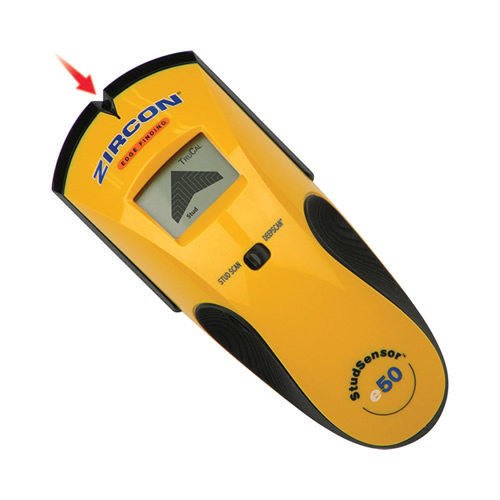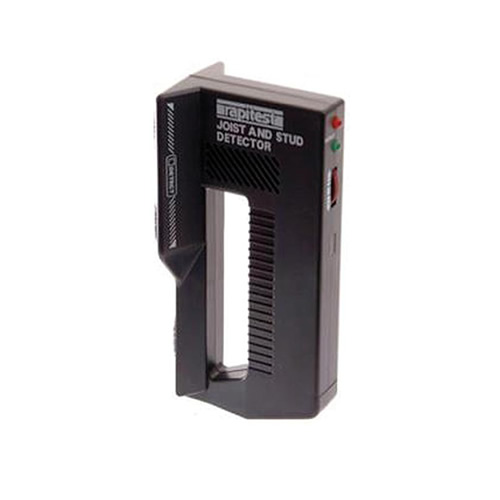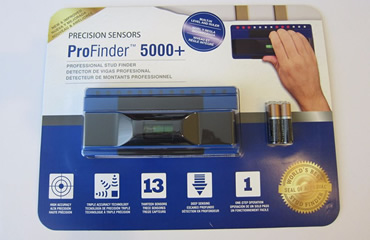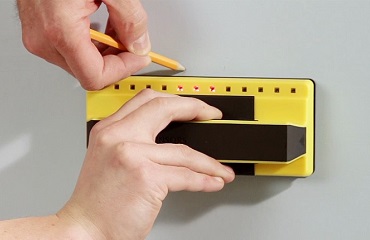Joist & Stud Detectors
Check out our article on the best joist, timber and stud detectors
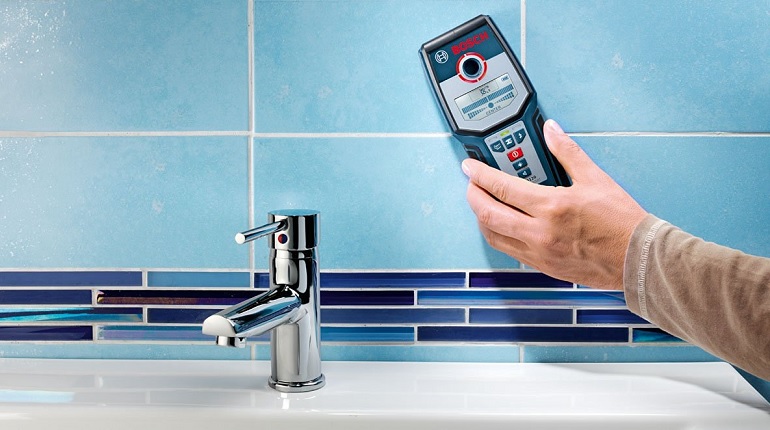
Finding timber joists/studs, pipes and cables behind plasterboard walls is an essential part of many DIY jobs. While avoiding pipes and cables is also important, there are many cheap metal detectors on sale which can help, but how do you find the timber joist beneath the plasterboard? The answer of course is by using a stud detector, unless you are a carpenter and you can simply rap your knuckles on the wall to accurately estimate the stud position! A stud detector makes fitting shelves, hanging pictures, putting up television brackets and microwave brackets much easier and safer, plus they are not terribly expensive so for the sake of a few pounds you can save a lot of time and unwanted holes drilled in the plasterboard.
A solid wall is made from brick, concrete or stone. Whereas a hollow wall will probably be a stud wall using a wooden frame with plasterboard panels which are plastered, painted or wallpapered over. Some walls can even be bits of both! The most common fixing when hanging items on walls is the Rawlplug and their are different types depending on the material and construction. Plasterboard plugs are available but can only be used for very light items, hanging a wall cabinet using a plasterboard fixing will likely not work out too well! For heavier items if you have a plasterboard wall, then you need to locate the wooden framework underneath, then use that as a secure fixing structure. In general, outside walls are likely to be brick or concrete solid walls, whereas interior walls are more likely to be stud walls. You can tell the difference by simply knocking on the wall and listening, stud walls will sound hollow. Whichever type of wall you have, ensure you buy the correct type of wall mount.
Most good joist/stud detectors operate on a similar principle, using magnetic or electronic systems for detection. Plus you get combination detectors which can also find pipes and wires by changing the settings. Stud detectors come with an instruction manual where you will probably be advised to practice on a section of wall where you know there to be timber, pipes or cables. This practice allows you to get the hang of the settings for the job you intend to use it for. Just pass the detector over the area and listen and/or watch for any indication, remember for a timber joist or stud, you will need to know its width and where it starts and ends, so unlike a cable/pipe detector, a single warning alert is not enough.
When hanging or securing anything from a stud wall, you need to bear in mind that if the fastener being used is driven into just plasterboard, the item is likely to rip out of the wall. On stud walls, you need to locate either a stud or another framing member to use as a secure fixing. Locating a stud can be difficult without the right equipment, and stud finders come in a variety of types so it’s important to know the difference between them and which is best for your project or needs.
Our favourite joist and stud detectors
-
Best Detector
Zircon StudSensor e50 Stud Finder
£38 -
Budget Detector
Rapitest Js 103 Joist Detector
£10
The two main types of stud detector are magnetic or electronic (aka internal capacitor type). Magnetic stud scanners use either stationary or moving magnets to detect the presence of the stud under the surface of the wall. The moving magnet types are more expensive but are more useful with heavily plastered walls. The best detectors use a neodymium magnet that is free to move and is capable of detecting studs through almost any surface to greater depths. The internal capacitor or electronic stud detectors use a plate that can detect changes in the electromagnetic composition/density of the wall, this change in density usually indicates a framing stud has been found.
These electronic stud detectors are the most common type of stud finder on sale and they come in three different types: edge finders, centre finders and instant finders. Edge finders detect changes in wall densities that indicate the edge of a framing stud. Centre finders have multiple sensors that can detect various changes in electromagnetic flux to pinpoint the centre of a stud. Whereas instant finders usually have multiple sensor plates with multiple sensors that can find both the centre of a stud, and the location of multiple studs in the wall simultaneously.
Zircon StudSensor e50 Stud Finder
One of the best stud detectors available is the Zircon StudSensor e50 Electronic Stud Finder model. From around £40 in the UK, this electronic stud detector easily locates studs behind walls, floors and ceilings. The Zircon StudSensor e50 can locate the edge of wooden or metal studs behind walls up to 19mm thick and even features a "DeepScan" mode which doubles the scanning depth to 38mm. The LCD display is really easy to read and indicates when a stud edge is approached with a pointer which shines an arrow shaped light onto the surface to mark the position. For safety there is also live wire detection up to 51 mm deep. Zircon were the manufacturer of the original StudSensor and this latest e50 model is the next generation. The StudSensor e50 is comfortable to hold for long periods with its patent-pending pinch grip design which has been moulded specifically to fit in the palm of your hand.
Rapitest Js 103 Joist Detector
A cheaper option is the still useful Rapitest Js 103 Joist and Stud Detector. For around £10 this detector offers the ability to electronically sense through walls, floors and ceilings to pinpoint solid timber joists and studs to prevent accidental damage when hanging or fixing items. The Rapitest Joist and Stud Detector allows you to easily find the right fixing point for shelves, cupboards & wardrobes, mirrors, pictures, clocks and lights. The unit comes complete with comprehensive instructions but is fairly intuitive to use in any case. Obviously at this price it is unfair to expect the Rapitest Js 103 to offer the same features as the more expensive Zircon StudSensor e50, but in the main, it does a pretty good job - though the fact that the required 9V alkaline battery is not included with the unit does scream of penny pinching!


